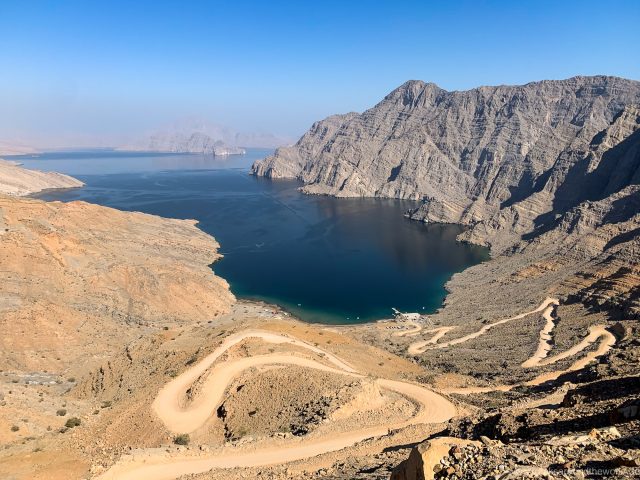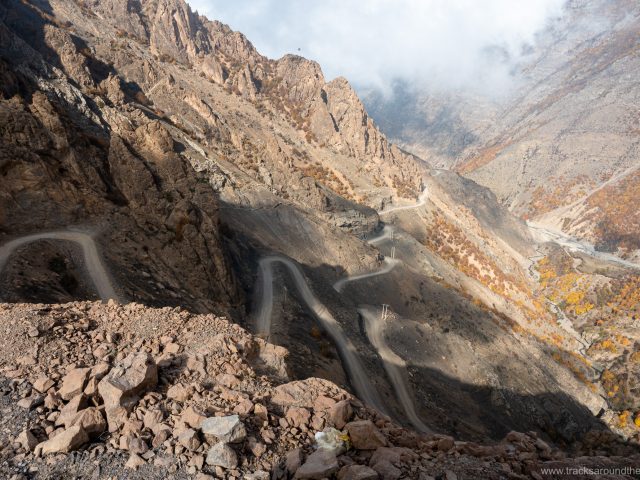At 6:00 a.m. we arrive at the border between Kazakhstan and Uzbekistan near Beineu, which is closed to tourists. It is currently undergoing extensive renovations, and only heavy commercial vehicles are allowed through to limit traffic. Alternative border crossings would be several thousand kilometers away, so of course we give it a try: Shujaa, with its 18 tons, is undoubtedly a heavy truck, and – certainly helpful – all the trucks in front of us in the queue are also MANs… so, at least in terms of appearance, we fit in perfectly. To our surprise, we are soon waved into the border area, and the processing begins – we don’t even have to mention the arguments and documentation explaining why we’re actually traveling with our heavy truck on a business mission and not for tourism 😉. No one asks about it or starts arguing with us. We are very surprised. Only the weight on the vehicle registration document matters, so we entered Uzbekistan after 2.5 hours and didn’t have to take long detours like many other travelers before and after us.
Besides the size and weight of our vehicle, what certainly helped was that we arrived at the border alone. As we have experienced ourselves, many travelers go together in such perceived difficult situations and arrive at the border in groups… the logic is that together as a team you’re supposedly stronger! This, of course, significantly reinforces the impression of being a “tourist overlander group,” with the consequence that they and subsequent travelers are turned away. Although we were also traveling with another overlander couple until the day before, we prefer to travel “low profile” in such situations and face the challenges alone.
Western Uzbekistan is empty and desert-like… while in Kazakhstan there was steppe with horses and camels, here there is NOTHING: just rocks and sand! So, we first drive 500 km through no man’s land – fortunately on a new, very well-developed road (thanks to the Chinese and their “New Silk Road” project!). The city of Nukus is our first destination, with the museum of the famous Russian painter Savitsky… it is considered the MOMA of Central Asia. Working as an archaeologist in former Soviet Uzbekistan, he collected a total of more than 40,000 paintings, folk art, and archaeological treasures over 30 years; most of them were considered undesirable in the former Soviet Union… one reason why so many artists had retreated to the remote desert of western Uzbekistan.
We continue past the “Towers of Silence” of the Zoroastrian period, which we had already visited in Iran, and various mud castles further east. Khiva is a mud-built fairy tale from 1,001 Nights – and that’s despite the old town measuring “only” 420 x 720 meters. Everywhere you look, you’ll find ornate blue-turquoise minarets, mosques, and madrasas (former Koranic schools). We’ve never seen the intricate woodwork and its decorations like this before! The heat (it’s now 35 degrees Celsius) combined with the extremely dry desert wind makes sightseeing exhausting. In the evening, we go to a local restaurant and spent the equivalent of € 8… we haven’t had such a cheap dinner for a long time!
Bukhara – another 400 km east through the desert – is the second of three oriental fairytale cities in Uzbekistan. Completely different from Khiva: larger, with more elegant shops, busier, and the tourists are more spread out in the numerous bazaars. The colorfully illuminated sights are particularly impressive at night. Once again, we find a central, but unfortunately not entirely quiet, parking spot right next to the old town wall and stay for two nights. However, the temperatures and the hot desert wind make it a bit exhausting too!
Samarkand, the third and final city, takes things up a notch with its rather scattered sights. They are not located in a coherent old town: Samarkand is, along with Rome, the oldest city on our planet! We start at the Registan, a former sand square built in the 14th century as the city center (so that camels could rest and lie down after long caravan journeys!), surrounded by three beautiful and magnificently decorated madrasas. Certainly, the most impressive building we’ve seen so far on the Silk Road. The Bibi Khanym Mosque is also very remarkable, before we visit another absolute highlight, the Shah-i Zinda necropolis: a densely packed collection of fabulously beautiful mausoleums of wealthy individuals from the 12th to 15th centuries. Fascinating and truly breathtaking!
When touring cities (especially three in a row in this climate), we realize that we are not getting any younger and after only one week we leave Uzbekistan for the hopefully more relaxing mountains and nature in Tajikistan.













































































































